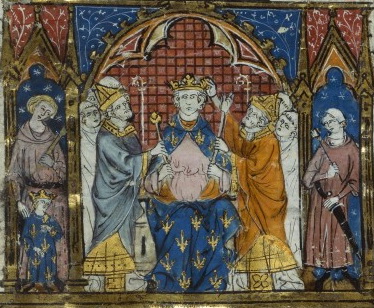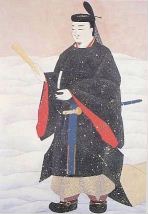|
Ichijō Tsunemichi
, son of regent Uchitsune, was a ''kugyō'' or Japanese court noble of the Muromachi period The , also known as the , is a division of Japanese history running from approximately 1336 to 1573. The period marks the governance of the Muromachi or Ashikaga shogunate ( or ), which was officially established in 1338 by the first Muromachi ... (1336–1573). He held a regent position kampaku from 1338 to 1342. Tsunetsugu was his adopted son. Family * Father: Ichijo Uchitsune * Mother: daughter of Saionji Kin’aki * Wife: Toin no Rinzu * Children: ** Ichijo Uchitsugu (1335/1336-1352?) ** Ichijo Fusatsune (1347/1348-1366) ** Jisai ** Genru * Adopted Son: Ichijo Tsunetsugu References * 1317 births 1365 deaths Fujiwara clan Ichijō family People of the Kamakura period People of the Nanboku-chō period {{japan-noble-stub ... [...More Info...] [...Related Items...] OR: [Wikipedia] [Google] [Baidu] |
Ichijō Uchitsune
, son of Uchisane, was a ''kugyō'' or Japanese court noble of the Kamakura period The is a period of History of Japan, Japanese history that marks the governance by the Kamakura shogunate, officially established in 1192 in Kamakura, Kanagawa, Kamakura by the first ''shōgun'' Minamoto no Yoritomo after the conclusion of the G ... (1185–1333). He held a regent position kampaku from 1318 to 1323. Tsunemichi was his son. Family * Father: Ichijo Uchisane * Mother: daughter of Ichijo Sanetsune * Wife: daughter of Saionji Kin’aki * Son: Ichijo Tsunemichi by daughter of Saionji Kin’aki References * 1291 births 1325 deaths Fujiwara clan Ichijō family People of the Kamakura period {{japan-noble-stub ... [...More Info...] [...Related Items...] OR: [Wikipedia] [Google] [Baidu] |
Kugyō
is the collective term for the very few most powerful men attached to the court of the Emperor of Japan in pre-Meiji eras. The term generally referred to the and court officials and denoted a court rank between First Rank and Third Rank under the '' Ritsuryō'' system, as opposed to the lower court nobility, thus being the collective term for the upper court nobility. However, later on some holders of the Fourth Rank were also included. In 1869, following the Meiji Restoration, the court nobility and daimyo were merged into a new peerage, the '' kazoku''. Overview The ''kugyō'' generally refers to two groups of court officials: * the ''Kō'' (公), comprising the Chancellor of the Realm, the Minister of the Left, and the Minister of the Right; and * the ''Kei'' (卿), comprising the Major Counsellor, the Middle Counsellor, and the Associate Counselors, who held the court rank of Third Rank or higher. History The ''kugyō'' originated from the Three Lords a ... [...More Info...] [...Related Items...] OR: [Wikipedia] [Google] [Baidu] |
Muromachi Period
The , also known as the , is a division of Japanese history running from approximately 1336 to 1573. The period marks the governance of the Muromachi or Ashikaga shogunate ( or ), which was officially established in 1338 by the first Muromachi ''shōgun'', Ashikaga Takauji, two years after the brief Kenmu Restoration (1333–1336) of imperial rule was brought to a close. The period ended in 1573 when the 15th and last shogun of this line, Ashikaga Yoshiaki, was driven out of the capital in Kyoto by Oda Nobunaga. From a cultural perspective, the period can be divided into the Kitayama and Higashiyama cultures (later 15th – early 16th centuries). The early years from 1336 to 1392 of the Muromachi period are known as the or Northern and Southern Court period. This period is marked by the continued resistance of the supporters of Emperor Go-Daigo, the emperor behind the Kenmu Restoration. The Sengoku period or Warring States period, which begins in 1465, largely overlaps ... [...More Info...] [...Related Items...] OR: [Wikipedia] [Google] [Baidu] |
Ichijō Tsunetsugu
, son of Nijō Yoshimoto and adopted son of regent Ichijō Tsunemichi, Tsunemichi, was a ''kugyō'' or Japanese court noble of the Muromachi period (1336–1573). He held a regent position kampaku three times from 1394 to 1398, from 1399 to 1408, and from 1410 to 1418. He married a daughter of Takatsukasa Fuyumichi, and the couple had a son named . His other wife gave birth to Ichijō Kaneyoshi, Kaneyoshi. Family * Foster Father: Ichijo Tsunemichi * Father: Nijo Yoshimoto * Wives: ** Takatsukasa Fuyumichi‘s daughter ** Hisashiboji Hidenaga’s daughter ** Sono Motosada’s daughter ** Servant (name unknown) * Children: ** Ichijo Tsunesuke (1392-?) by Takatsukasa Fuyumichi‘s daughter ** Ichijo Kaneyoshi by Hisashiboji Hidenaga’s daughter ** Yugen by Hisashibojo Hidenaga’s daughter ** Zosai by Hisashibojo Hidenaga’s daughter ** Unsho Ikkei (1386-1463) by Sono Motosada’s daughter ** Gingen (d.1441) by Servant ** Zoshi (d.1460) by Servant References * 1358 births 1 ... [...More Info...] [...Related Items...] OR: [Wikipedia] [Google] [Baidu] |
1317 Births
Year 1317 ( MCCCXVII) was a common year starting on Saturday of the Julian calendar. Events January – March * January 9 – The 23-year-old Philip the Tall, younger brother of the late King Louis X of France, is hastily crowned King of France, as King Philip V, at Rheims. The only son of King Louis X had been born posthumously, but died after four days. Supporters of King Louis felt that his eldest daughter, Joan II of Navarre, should have been crowned as the monarch. Mass protests follow in Artois, Champagne and Burgundy. The coronation of a brother, instead of the eldest daughter, as the successor to the throne sets the precedent for the Salic law, providing that the eldest male heir inherits the throne. Philip V reorganizes the French army by extending the military obligations of the realm. Each town and castellany is responsible for providing a specified number of fully equipped troops – such as sergeants and infantry militias, while towns in economically adva ... [...More Info...] [...Related Items...] OR: [Wikipedia] [Google] [Baidu] |
1365 Deaths
Year 1365 (Roman numerals, MCCCLXV) was a common year starting on Wednesday of the Julian calendar. Events January–December * March 3 – Battle of Gataskogen: Albert, King of Sweden, Albert of Mecklenburg defeats and captures Magnus IV of Sweden, Magnus Eriksson, obtaining the throne of Sweden. * March 12 – The University of Vienna is founded. * June 2 – The Hungarian occupation of Vidin begins, with the capture of the city by Louis I of Hungary's forces, and the imprisonment of Ivan Sratsimir of Bulgaria. * October – Alexandrian Crusade: The city of Alexandria in Egypt is sacked by an allied force of Peter I of Cyprus and the knights of the Knights Hospitaller, Order of St. John of Jerusalem. * November 30 – The ''Nagarakretagama'', a Javanese eulogy chronicling the journey of the Majapahit king, Hayam Wuruk, through his kingdom, is completed by Mpu Prapanca. Date unknown * Adrianopole (modern-day Edirne) becomes the capital city of the ... [...More Info...] [...Related Items...] OR: [Wikipedia] [Google] [Baidu] |
Fujiwara Clan
The was a powerful family of imperial regents in Japan, descending from the Nakatomi clan and, as legend held, through them their ancestral god Ame-no-Koyane. The Fujiwara prospered since ancient times and dominated the imperial court until the Meiji Restoration in 1868. They held the title of Ason. The abbreviated form is . The 8th century clan history states the following at the biography of the clan's patriarch, Fujiwara no Kamatari (614–669): "Kamatari, the Inner Palace Minister who was also called ‘Chūrō'',''’ was a man of the Takechi district of Yamato Province. His forebears descended from Ame no Koyane no Mikoto; for generations they had administered the rites for Heaven and Earth, harmonizing the space between men and the gods. Therefore, it was ordered their clan was to be called Ōnakatomi" The clan originated when the founder, Nakatomi no Kamatari (614–669) of the Nakatomi clan, was rewarded by Emperor Tenji with the honorific "Fujiwara"after the w ... [...More Info...] [...Related Items...] OR: [Wikipedia] [Google] [Baidu] |
Ichijō Family
The was a Japanese aristocratic kin group. Papinot, Jacques Edmond Joseph. (1906). ''Dictionnaire d’histoire et de géographie du Japon''; Papinot, (2003)"Ichijō," ''Nobiliare du Japon'', p. 13 retrieved 2013-7-7. The Ichijō was a branch of the Fujiwara clan, Nussbaum, Louis-Frédéric. (2005)"Ichijō"in ''Japan Encyclopedia'', p. 368. founded by Kujō Michiie's son Ichijō Sanetsune and was one of the Five regent houses, from which the Sesshō and Kampaku were chosen. Genealogy Tosa-Ichijō clan The , a cadet branch of the Ichijō family, was established during the chaos of Ōnin War. In 1475, Ichijō Norifusa, the 9th head of the family, fled from Kyoto to Tosa Province, where one of the fiefdoms the family held by the time; some descendants of Norifusa stayed in Tosa for generations. The family, however, eventually lost control of Tosa during the reign of Ichijō Kanesada since 1575. The following is the lis ... [...More Info...] [...Related Items...] OR: [Wikipedia] [Google] [Baidu] |
People Of The Kamakura Period
The term "the people" refers to the public or common mass of people of a polity. As such it is a concept of human rights law, international law as well as constitutional law, particularly used for claims of popular sovereignty. In contrast, a people is any plurality of persons considered as a whole. Used in politics and law, the term "a people" refers to the collective or community of an ethnic group or nation. Concepts Legal Chapter One, Article One of the Charter of the United Nations states that "peoples" have the right to self-determination. Though the mere status as peoples and the right to self-determination, as for example in the case of Indigenous peoples (''peoples'', as in all groups of indigenous people, not merely all indigenous persons as in ''indigenous people''), does not automatically provide for independent sovereignty and therefore secession. Indeed, judge Ivor Jennings identified the inherent problems in the right of "peoples" to self-determination, as i ... [...More Info...] [...Related Items...] OR: [Wikipedia] [Google] [Baidu] |


